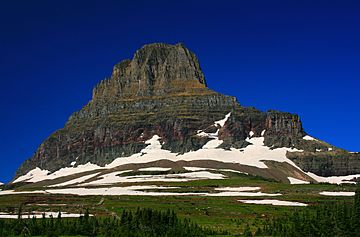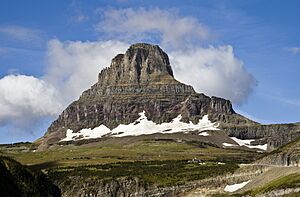Clements Mountain facts for kids
Quick facts for kids Clements Mountain |
|
|---|---|

Clements Mountain
|
|
| Highest point | |
| Elevation | 8,765 ft (2,672 m) NAVD 88 |
| Prominence | 920 ft (280 m) |
| Listing | Mountains of Glacier National Park |
| Geography | |
| Location | Glacier County, Montana, Flathead County, Montana, U.S. |
| Parent range | Lewis Range |
| Topo map | USGS Logan Pass, MT |
| Climbing | |
| First ascent | August 13, 1923 (Norman Clyde) |
Clements Mountain is a tall peak in the Lewis Range, found within Glacier National Park in Montana, U.S.. It stands about 8,765 feet (2,672 meters) high.
This mountain is located west of Logan Pass. It rises above the Hidden Lake Trail, which takes you to Hidden Lake. This lake is just west of the Continental Divide.
Clements Mountain was named after Walter M. Clements. He helped create an important agreement. This agreement was between the Blackfeet Nation and the U.S. Government. It allowed for the purchase of tribal lands east of the Continental Divide. These lands later became part of Glacier National Park.
What is Clements Mountain Made Of?
Just like other mountains in Glacier National Park, Clements Mountain is made of sedimentary rock. This type of rock forms from layers of sand, mud, and tiny bits of plants and animals that settle over time.
How the Rocks Were Formed
The rocks in Clements Mountain were laid down a very long time ago. This happened during periods known as the Precambrian and Jurassic eras. Back then, this area was covered by shallow seas. Over millions of years, layers of sediment built up and turned into rock.
The Lewis Overthrust
About 170 million years ago, something huge happened. A massive geological event called the Lewis Overthrust began. This event pushed an enormous slab of very old rock, about 3 miles (4.8 km) thick, over much younger rock. This slab was 50 miles (80 km) wide and 160 miles (260 km) long. It slid over rocks from the Cretaceous period. This powerful movement helped create the mountains we see today, including Clements Mountain.




